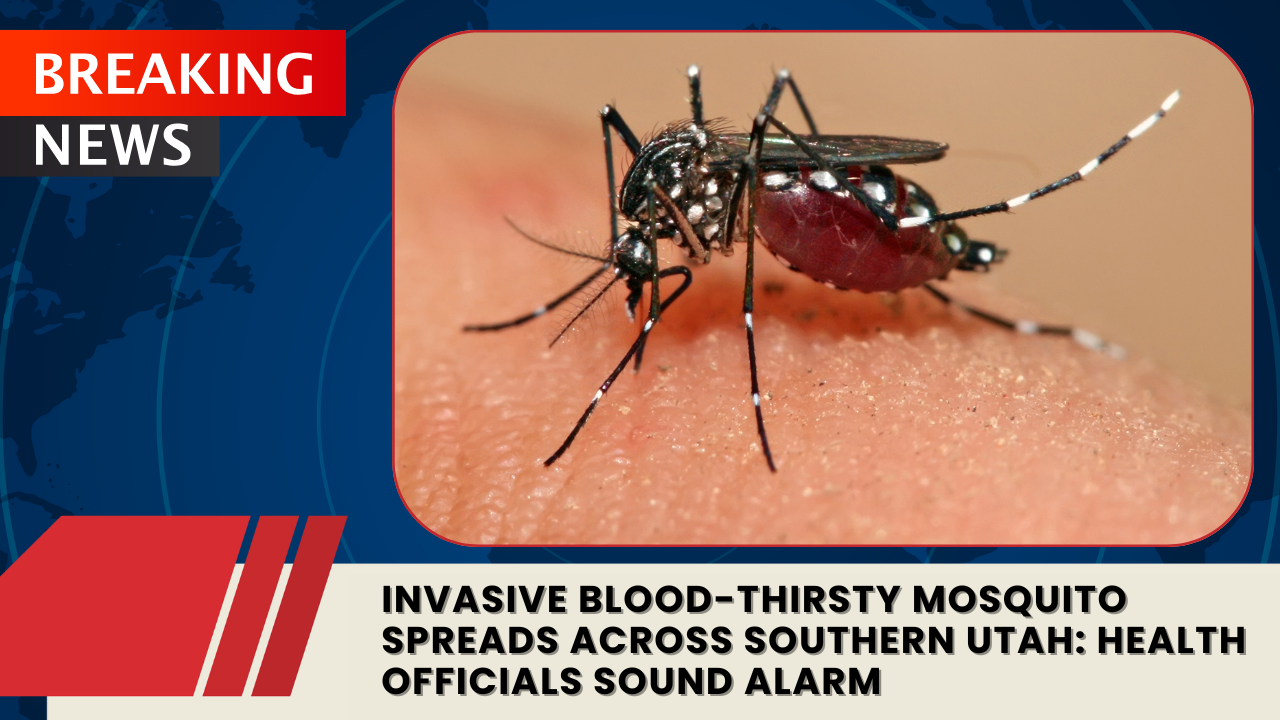An invasive mosquito species capable of spreading dengue, Zika, West Nile virus, and other deadly diseases is rapidly expanding its presence across southern Utah, prompting urgent action from public health officials.
The Aedes aegypti mosquito, known for its preference for human blood and daytime biting habits, has been detected in several Washington County communities, including St. George, Hurricane, Washington City, Santa Clara, and Springdale.
Local mosquito abatement crews are battling to contain the outbreak as reports of painful, red welts and increased bite activity surge following recent monsoon storms that left behind pools of standing water — ideal breeding grounds for the species.
Aedes Aegypti: The Aggressive Daytime Biter
Unlike most mosquitoes that bite at dusk or dawn, Aedes aegypti are active throughout the day. Females are particularly aggressive, often biting up to a dozen times in a single feeding session to gather the protein needed to produce eggs.
“These mosquitoes are urban dwellers — they thrive in neighborhoods and backyards,” explained Sean Amodt, manager of the Southwest Mosquito Abatement District. “We’re hearing from residents every day saying, ‘Help, we’re getting eaten alive.’”
Over the past month, the district has received more than 40 service requests from homeowners seeking help eradicating infestations
The Health Risk: Why Officials Are Concerned
While no human cases of dengue, chikungunya, Zika, or yellow fever have been confirmed in Utah this year, one mosquito pool tested positive for West Nile virus, according to David Heaton, spokesperson for the Southwest Utah Public Health Department.
“We don’t currently have any of those diseases circulating here,” Heaton noted. “But the concern is always that they could be introduced — and these mosquitoes are capable of spreading them quickly.”
Health officials warn that all it would take is one infected traveler returning to Utah for the viruses to establish local transmission.
How the Invasive Mosquito Arrived in Utah
The Aedes aegypti was first detected in Washington County in 2013, but it reappeared in 2020 and has been expanding ever since. Experts believe the species likely spread through potting soil, mulch, or ornamental plants transported from infested regions.
The mosquito’s eggs can survive for months in dry conditions, hatching once water levels rise. Common breeding spots include:
- Birdbaths and plant saucers
- Discarded tires or buckets
- Flower pots and garden decorations
- Even bottle caps that collect rainwater
With life cycles as short as two to four weeks, populations can explode quickly under warm, wet conditions.
What the Mosquito Abatement Teams Are Doing
Mosquito abatement crews are using foggers and larvicide treatments to kill adult mosquitoes and destroy breeding sites. Workers are also distributing public health pamphlets urging residents to take part in prevention by removing standing water around their homes.
Finding the source of infestations, however, can be a challenge. “Sometimes we have to check several blocks to find the exact spot,” Amodt said. “Even one small puddle or flowerpot can keep an entire neighborhood infested.”
Officials recommend the “Tip and Toss” method — tipping out water from containers and tossing items that collect rainwater.
Identifying the Pest
Aedes aegypti mosquitoes are easily recognized by their distinctive black-and-white stripes and a lyre-shaped marking on their upper body. They are often mistaken for “no-see-ums,” but unlike those tiny midges, these mosquitoes are visible — and highly aggressive.
They prefer to bite ankles, wrists, and other thin-skinned areas, often leaving behind large, painful welts. Some residents have sought medical attention due to severe allergic reactions.
How Long the Threat Will Last
Health officials expect Aedes aegypti activity to persist from May through November, depending on weather conditions. Even with aggressive control measures, eradicating the pest completely is unlikely.
Residents experiencing mosquito infestations can request assistance from the Southwest Mosquito Abatement District by calling 435-627-0076 or submitting a service form online.
For now, officials are urging vigilance and prevention: dump out water, use repellents with DEET, and wear long sleeves outdoors.
“This mosquito is here,” said Amodt. “We just need to make sure it doesn’t become a permanent part of southern Utah life.”



